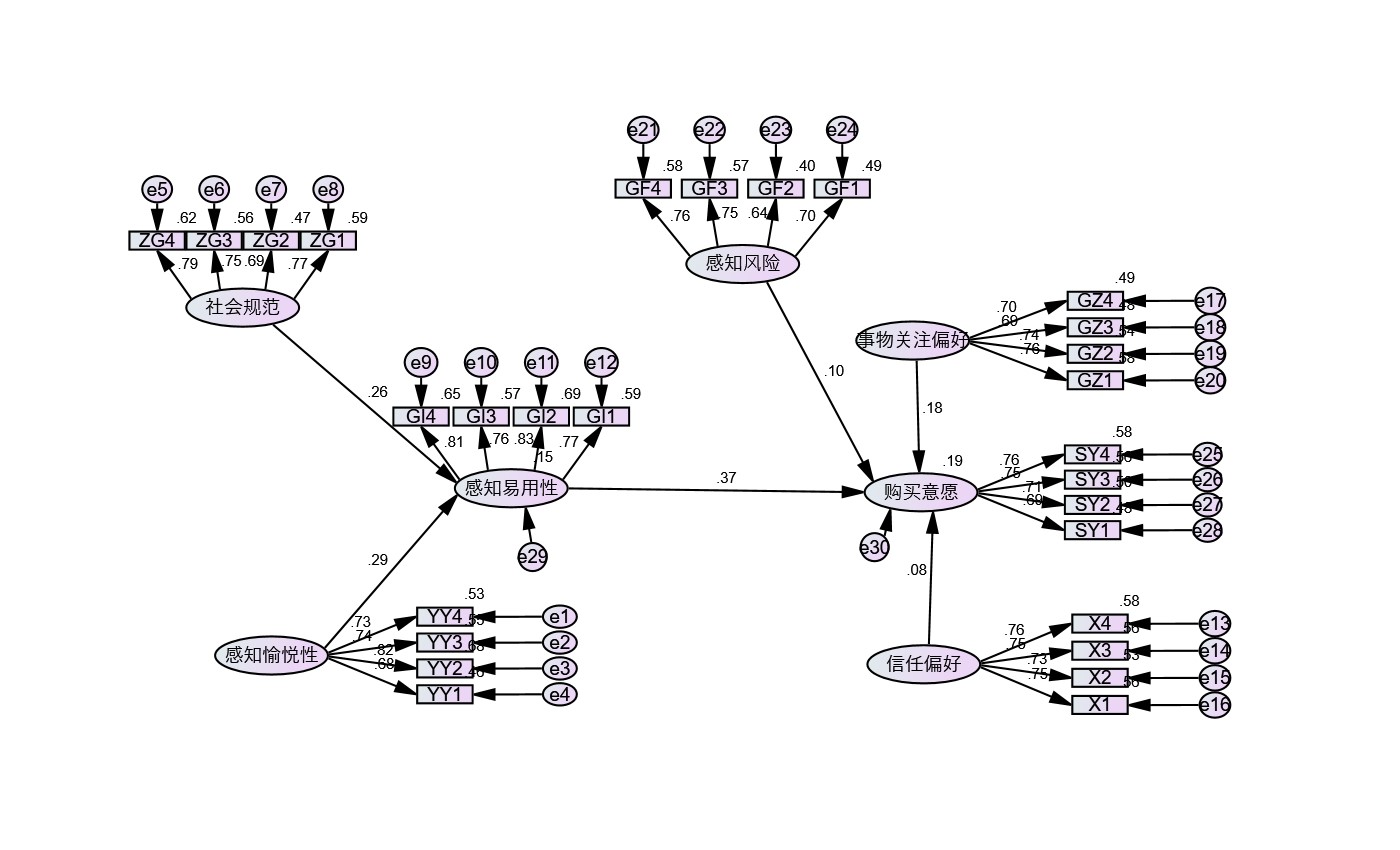 PDF(1231 KB)
PDF(1231 KB)


 PDF(1231 KB)
PDF(1231 KB)
 PDF(1231 KB)
PDF(1231 KB)
“VR+网络购物”模式下大学生购买意愿影响因素研究
Research on the Influencing Factors of College Students' Purchase Intention Under the Mode of "VR + online Shopping"
[目的/意义] 近些年随着VR产业的不断发展,有关此方面的研究也开始增加。通过对VR营销方式下大学生购买意愿进行研究,在以往学者研究的基础上加入个人偏好等因素,对网络购物模式的相关研究进行补充,并为采用VR方式营销的商家提供建议。[方法/过程] 以技术接受理论为基础,从消费者个人角度及社会角度出发,对大学生网上购物时购买意愿影响因素模型进行构建,并利用SPSS及AMOS对模型进行检验,最终得出结论。[结果/结论] 通过研究发现,感知愉悦性和社会规范对感知易用性存在显著正向影响,感知易用性对大学生网络购物时的购买意愿存在显著正向关系,信用偏好和事物关注偏好对大学生网络购物时的购买意愿存在显著正向影响,感知风险对购买意愿存在显著正向影响。
[Purpose/significance] With the continuous development of the VR industry in recent years, research in this area has also begun to increase. In this paper, through the research of College Students' purchase intention under VR marketing mode, factors such as personal preference are added on the basis of predecessors' research, to supplement the relevant research of online shopping mode, and to provide recommendations for merchants using VR marketing. [Method/process] Based on the technology acceptance theory, this paper built a model of factors that influence College Students' willingness to purchase when they shop online, and used SPSS and AMOS to test the model from the perspective of consumers' personal and social perspectives and draw conclusions. [Result/conclusions] It is found that perceived pleasure and social norms have a significant positive impact on perceived ease of use, perceived ease of use has a significant positive relationship with college students' purchase intention in online shopping, credit preference and attention preference have a significant positive correlation with college students' purchase intention in online shopping, and perceived risk has a significant positive correlation with purchase intention.

virtual reality / purchase intention / user preferences / online shopping
| [1] |
中国互联网络信息中心.中国互联网络发展状况统计报告 (2021年2月)[EB/OL].[2021-02-03].http://www.cnnic.net.cn/.
|
| [2] |
GUTTENTAG D A. Virtual reality: applications and implications for tourism[J].Tourism management,2010,31(5):637-651.
|
| [3] |
MADATHIL K C, GREENSTEIN J S. An investigation of the efficacy of collaborativevirtual reality systems for moderated remote usability testing[J].Applied ergonomics,2017,65:501-514.
|
| [4] |
JIANG Z H, BENBASAT I. Investigating the influence of the functional mechanisms of online product presentations[J].Information systems research,2007,18(4):454-470.
|
| [5] |
安柯洁.“互联网+”VR技术在大学生消费中的应用研究[J].中国多媒体与网络教学学报(上旬刊),2020(6):6-7.
|
| [6] |
王晓哲,张金斗.基于虚拟展示的心流体验对购买意愿影响研究[J].福建茶叶,2019,41(10):33-34.
|
| [7] |
陈德贞,郑圣杰,吴嘉伟.“VR+购物”的市场发展前景及其策略研究[J].科技风,2019(33):200-201.
|
| [8] |
DAVIS F D. Perceived usefulness, perceived ease of use, and user acceptance of information technology[J]. MIS quarterly,1989,13(3):319-340.
|
| [9] |
SZAJNA B. Empirical evaluation of the revisedtechnology acceptance model[J].Management science,1996,42(1):85-92.
|
| [10] |
赵雪芹,王少春.微信小程序用户持续使用意愿的影响因素探究[J].现代情报,2019,39(6):70-80,90.
|
| [11] |
陈传红,李雪燕.市民共享单车使用意愿的影响因素研究[J].管理学报,2018,15(11):1601-1610.
|
| [12] |
IGBARIA M, ZINATELLI N, CRAGG P, et al. Personal computing acceptance factors in small firms: a structural equation model[J].MIS quarterly,1997,21(3):279-305.
|
| [13] |
DIWANJI V S, CORTESE J. Contrasting user generated videos versus brand generated videos in ecommerce[DB/OL].[2021-05-30]. https://www.sciencedirect.com/science/article/pii/S096969891930863X.
|
| [14] |
FISHBEIN M, AJZEN I. Belief, attitude, intention and behavior: an introduction to theory and research[EB/OL].[2021-05-30].https://www.researchgate.net/publication/233897090_Belief_attitude_intention_and_behaviour_An_introduction_to_theory_and_researc.
|
| [15] |
Nedra BA, HADHRI W, MEZRANI M. Determinants of customers' intentions to use hedonic networks: the case of instagram[J].Journal of retailing and consumer services,2019,46:21-32.
|
| [16] |
KAUSHIK A K,RAHMAN Z. An alternative model of self-service retail technology adoption[J].Journal of services marketing.2015,29(5):406-420.
|
| [17] |
VENKATESH V, BALA H. Technology acceptance model 3 and a research agenda on interventions[J].Decision sciences,2008,39(2):273-315.
|
| [18] |
刘冰冰,谢圣恩.社会化媒体对旅游者购买意愿的影响因素研究[J].价值工程,2015,34(21):5-9.
|
| [19] |
LIN W H, XU A X, ZHENG Q Q, et al. Influence of customer perceived value on the online shopping intention of aquatic products under B2C E-commerce[J].Journal of discrete mathematical sciences & cryptography,2018,21(6):1189-1192.
|
| [20] |
STONE R N, GRØNHAUG K. Perceived risk: further considerations for the marketing discipline[J].European journal of marketing,1993,27(3):39-50.
|
| [21] |
CUNNINGHAM S M. The major dimensions of perceived risk[M]//COX D F. Risk taking and information handing in consumer behavior. Boston: Harvard University Press,1967.
|
| [22] |
MITCHELLV W. Consumer perceived risk: conceptualizations and models[J].European journal of marketing,1999,33(1/2):163-195.
|
| [23] |
GARBARINO E,STRAHILEVITZ M. Gender differences in the perceived risk of buying online and the effects of receiving a site recommendation[J].Journal of business research,2004,57(7):768-775.
|
| [24] |
OUTREVILLE J F, DESROCHERS J. Perceived risk: an experimental investigation of consumer behavior when buying wine[J].Journal of consumer behaviour,2016,15(6):549-559.
|
| [25] |
王阳,王伟军,刘智宇.在线负面评论信息对潜在消费者购买意愿影响研究[J].情报科学,2018,36(10):156-163.
|
| [26] |
刘明波,王伊琳,周志刚.渠道信任、保险印象与购买意愿——基于微观个体的调查研究[J].保险研究,2014(4):63-73.
|
| [27] |
LIM K H, SIA C L, LEE M K O, et al. Do I trust you online, and if so, will I buy? an empirical study of two trust-building strategies[J].Journal of management information systems,2006,23(2):233-266.
|
| [28] |
赵金楼,成俊会.基于用户感知、偏好和涉入的微博舆情传播意愿影响因素研究[J].情报学报,2014,33(4):416-425.
|
| [29] |
AGARWAL R, KARAHANNA E. Time flies when you're having fun: cognitive absorption and beliefs about information technology usage[J].MIS quarterly,2000,24(4):665-694.
|
| [30] |
VENKATESH V,DAVIS F D.A Theoretical extension of the technology acceptance model: four longitudinal field studies[J].Management science,2000,46(2):186-204.
|
| [31] |
MACKENZIE S B,LUTZ R J,BELCH G E. The role of attitude toward the ad as mediator of advertising effectiveness: a test of competing explanations[J].Journal of marketing research,1986,23(2): 130-143.
|
| [32] |
殷猛,李琪.基于保护动机理论的健康APP用户使用研究[J].现代情报,2016,36(7):63-70.
|
| [33] |
汤少梁,朱胡弘.基于技术接受模型的电子商务第三方信任机制研究[J].图书情报工作,2011,55(8):140-144,53.
|
/
| 〈 |
|
〉 |